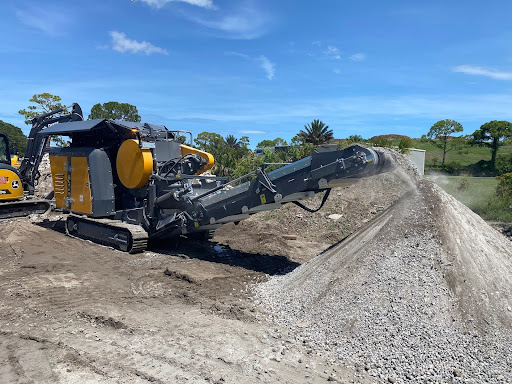Size reduction is among the most common practices in many material processing plants. The main aim is to get different sizes of rocks or concrete, mostly by reducing large lumps into conveyable sizes. There are several options for concrete reduction, including breakers, sizers, and crushers. This guide focuses on concrete crushers as a method for size reduction.
Table of Contents
What is a Concrete Crusher?
A concrete crusher is a machine designed to reduce material size through attrition, impact, shear or compression. Common types of concrete crushers include Cone Crushers, Jaw Crushers, Roll Crushers, Gyratory Crushers, Impact Crushers and Hammermill Crushers. Compression crushers work by compressing or squeezing concrete material between a stationary and moving piece of steel.
Impact crushers reduce material size through three mechanisms: material coming into contact with the spinning rotor, crushing via other material inside the chamber (material being flung around) and employing breaker plates on the walls of the crushing chamber. Most of these machines have attrition features that allow for further size reduction before releasing material.
Difference between Breakers and Crushers
Besides operation and physical features, breakers and crushers are designed for different performance and industrial applications. Breakers take advantage of the natural weakness that appears on the fracture line of the rocks to reduce their size. However, they are not well-suited for highly abrasive, wet and sticky materials.
On the other hand, crushers are capable of handling hard and abrasive materials. Other crushers, like impact crushers, can effectively handle sticky or wet materials like concrete. Therefore, the choice of crusher type can be based on the specific material you intend to work with.
Factors to Consider When Choosing a Concrete Crusher
Concrete, being one of the strongest materials, finds extensive use in infrastructure and building construction. During demolition, valuable material can be recycled for use in different projects instead of being dumped in landfills. For recycled concrete to be used, it must be reduced into different sizes for different projects. The first thing is to choose the right concrete crusher. Below is the guide to selecting a suitable concrete crusher.
Available Types of Concrete Crushers
It is important to understand the different types of concrete crushers available in the market. It is easier to move to more specific crusher features and characteristics once you know the basic types to explore. Popular types include Jaw, Cone and Impact crushers.
Size of the Crusher
The size of the machine you get will determine your transportation and storage options. You should check a particular region’s size and weight restrictions before buying a crusher. Also, you need to know where you will store your machine before purchasing to avoid disappointments.
Production Rates
Different concrete crushers have different productivity paces, defined by tons of processed materials per hour. Check the details in the brochures to know the pace of each machine before buying. However, the safest way is to talk with the machine operator, who can realistically measure the production numbers of the machine.
Output Size and Reduction Rate
You should choose a concrete crusher based on the type of product you need. Jaw crushers produce 3-8 minus coarse with a 4:1 reduction rate, while impact crushers can make ¾ minus or smaller with 15:1.
In the Nutshell
Concrete crushers are important equipment for the construction and mining industry. Therefore, select the right crusher for your needs. This means you should consider the tips above to be on the safer side.





